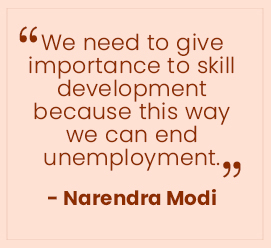India’s unemployment rate fell to 7.14% in January, the lowest in four months, from 8.30% in the previous month, data from the Centre for Monitoring Indian Economy (CMIE) showed on Wednesday.
The urban unemployment rate declined to 8.55% in January from 10.09% in the previous month, while the rural unemployment rate slipped to 6.48% from 7.44%, the data showed.
Controlling high inflation and creating jobs for millions of young people entering the workforce before the next round of national elections in 2024 continue to be the government of Prime Minister Narendra Modi’s main challenges. From the southern city of Kanyakumari to Srinagar, in the Jammu and Kashmir region, the main opposition Congress party began a five-month cross-country march in September to mobilize public opinion on issues like high prices, Indian unemployment rate, and what it claims are the divisive politics of Modi’s Bharatiya Janata party.
Rahul Gandhi, a senior leader of the Congress party, who is leading the party’s 3,500-kilometer (2,175 mile) march on foot, told reporters on Saturday that India needs to shift from a single focus on GDP growth to growth with employment, skilling of youth, and creating production capacities with export prospects. The government is trying their best to reduce India’s unemployment rate. According to separate quarterly figures prepared by the state-run National Statistical Office (NSO) and released in November, the unemployment rate decreased to 7.2% in the July-September quarter from 7.6% in the preceding quarter.
STATE WISE CURRENT UNEMPLOYMENT DATA (JANUARY 2023).
| State | Month | State | Month |
| Andhra Pradesh | 5.5 | Himachal Pradesh | 10.0 |
| Assam | 16.1 | Jammu & Kashmir | 21.8 |
| Bihar | 11.9 | Jharkhand | 13.8 |
| Chhattisgarh | 0.5 | Karnataka | 3.4 |
| Delhi | 16.7 | Kerala | 6.7 |
| Goa | 16.2 | Madhya Pradesh | 1.9 |
| Gujarat | 2.4 | Maharashtra | 5.5 |
| Haryana | 21.7 | Meghalaya | 2.6 |
| Odisha | 1.5 | Puducherry | 5.3 |
| Punjab | 6.8 | Rajasthan | 21.1 |
| Sikkim | 2.4 | Tamil Nadu | 1.8 |
| Telangana | 5.3 | Tripura | 16.0 |
| Uttar Pradesh | 4.2 | Uttarakhand | 2.2 |
| West Bengal | 5.0 |
The Unemployment Rates are produced by CMIE using its Consumer Pyramids Household Survey machinery. Production of these unemployment rates and their public distribution is sponsored by CMIE.
HIGHEST UNEMPLOYMENT RATE IN INDIA
Since January 2023, the employment rate has decreased, but the state with reaching a record high of unemployment is 21.8% in Jammu&Kashmir, 21.7% in Haryana, and 21.1% in Rajasthan, as per the CMIE recent Report.
LOWEST UNEMPLOYMENT RATE IN INDIA
According to the CMIE unemployment report in the month of January 2023, Chattisgarh has the lowest unemployment rate which is 0.5% and Odisha reports as the second lowest unemployed state with a 1.5% od rate.
THE UNEMPLOYMENT RATE FALLS BUT IS STILL TOO HIGH
The unemployment rate in India fell to 7.1 per cent in January 2023 from 8.3 per cent in December 2022. This is a sharp fall, not just from the December level but also the levels of the preceding two months that averaged around 8 per cent. Despite this substantial fall in January, the unemployment rate continues to remain elevated. An unemployment rate of over 7 per cent seems to be the new norm in India. This is rather high for a country that boasts to be among the fastest-growing economies in the world.
According to The Economist Newspaper (February 4th, 2023) which lists 43 countries (including an entry for the euro area), only 9 countries had an unemployment rate that was higher than India’s. These are Greece, Italy, Spain, Turkey, Brazil, Chile, Colombia, Egypt and Saudi Arabia. Over 30 countries did better than India on the unemployment rate front, although many recession prospects.
The fall in the unemployment rate in January 2023 compared to its level in December 2022 is likely to reflect largely a seasonal phenomenon. In five of the past six years, the unemployment rate in January was lower than it was in the preceding December. The average change between December and January was a 77 basis fall. This year, the unemployment fell by a sharper, 116 basis points between the two months. The fall in the unemployment rate in January 2023 could therefore be more than just a seasonal fall.
As large numbers of the unemployed left the labour markets in January 2023, the labour participation rate fell from 40.5 per cent in December 2022 to 39.8 per cent. This is India’s greater challenge, its equally volatile and falling labour force participation rate. Labour leaves the labour markets when the availability of jobs declines. As they leave, they do not get counted as unemployed and this causes the unemployment rate to fall giving a false sense of comfort that the situation in the labour market has improved.
The fall in the unemployment rate in January is not a source of comfort. It reflects a falling labour participation rate.
CAUSES OF UNEMPLOYMENT IN INDIA
In every nation, there are a variety of reasons that contribute to unemployment. Whether unemployment is brought on by a drop in the Labour force or a lack of jobs determines whether it will be temporary or permanent.
The main causes of unemployment in India are four different forms of unemployment. These four categories of unemployment include structural, frictional, seasonal, and cyclical. Through expansionary monetary policy, we may combat seasonal and cyclical unemployment by raising public spending when times are tough.
A few main causes of unemployment are:
- A sizable population
- The working population’s poor educational attainment or lack of vocational skills.
- Labour-intensive industries experiencing a downturn in private investment, especially the following demonetization.
- Transitioning between the three sectors is challenging due to the poor productivity in the agriculture sector and the dearth of alternatives for agricultural employees.
- Legal difficulties, insufficient government backing, and weak market, financial, and infrastructure ties to small firms render those operations unprofitable due to the cost and compliance overruns.
- Low investments in the manufacturing sector and inadequate infrastructural development, limit secondary sector job opportunities.
The government can build up a public employment program that produces full-time employment at minimum pay levels to create job stability, or it can provide temporary labour to unemployed individuals as part of the food-for-work program. Stabilizing market forces and lowering the trend toward structural changes or the necessity to fire people due to a lack of market demand, will lessen the cyclical type of unemployment.
WHAT ISFH FOUNDATION IS DOING FOR UNEMPLOYMENT
- Ensure that underprivileged children undergo an economic, social, and personal transformation.
- Identify the education skill gaps to get esteemed employment.
- Make the poor youth self-dependent and get a well-paid job.
- Offer a lifetime earning potential for the disadvantaged.
- Support vulnerable youth from unemployment or underemployment.











